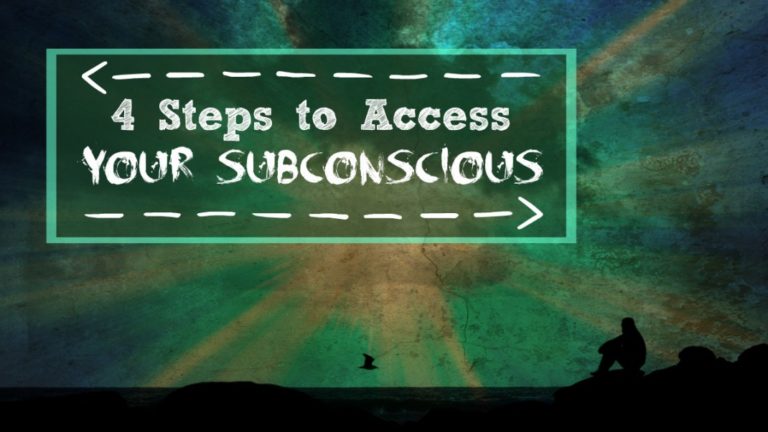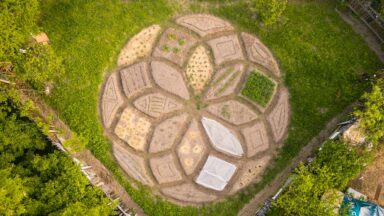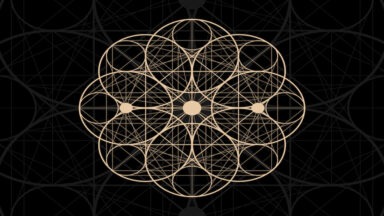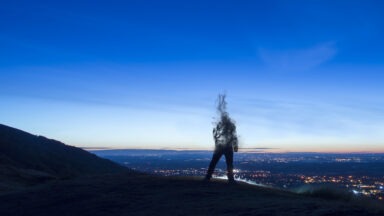How to Access Your Subconscious Mind in 4 Steps

“Logic can take you from point A to point B, but imagination can take you anywhere.” – Albert Einstein
How to Access your Subconscious Mind?
Exercise: Access your Subconscious Mind in 4 Steps
- Relax
Relaxation is challenging for many of us, but it’s the gateway to opening and moving deeper within ourselves. Find a place where you won’t be disturbed. Sit or lie down in a comfortable place. If you’re sitting, use a cushion or a folded blanket underneath to help your sitz bones relax the hip flexors and knees. If you’re lying down, roll your shoulder blades down your back to support the heart. Place the hands at your sides palms up, and let the legs and ankles splay out. Relax the eyes with a soft gaze or close them, whatever feels most comfortable for you.
- Listen
Listen to the sound of your breath. If your breath is fast and choppy, slow it down by taking long, slow breaths. This calms the mind. Listen to the sound of your heart beating in sync with the natural rhythms of your body. The more you listen and focus on the breath, the more you’ll arrive in the moment, at ease, letting go of thoughts.
- Find Guidance
Using a guided meditation or a yoga nidra recording can be a powerful way to encourage visualization and deeper meditation. Better yet, seek out a teacher. Guided meditations will help you set your intention for what you want to work on, from dealing with trauma to fulfilling dreams, getting rid of bad habits, etc.
Guided meditations can often be found free through many different apps. Another option is brain wave music, which moves the hemispheres of the brain into alpha, delta and theta states, which help to de-program old thought patterns.
- Be Consistent
The more frequent you practice, the better. Find the time of day that resonates with you most and stick to it. Want to complement your practice even more? Restorative yoga is incredibly beneficial for relaxation.
Accessing your subconscious can help change your harmful thought patterns and take you out of feeling like you’re living life on autopilot. With a regular practice, you’ll enjoy a new sense of well-being, passion and purpose.
Learn how to access the subconscious mind with this E-motion toolkit full-length video
In our day-to-day lives, we’re constantly in an alert, conscious state of mind. In the beta state, our brains are very active as we navigate through the day, sometimes feeling like we are on autopilot as we form our experiences. In this active beta state, our brain is over-stimulated, which in yoga is often referred to as “the monkey mind.” Here, everything comes to us as doubts, fears, to-dos, emotions, and it can really cloud our minds and trains of thought.
Studies have shown that in our conscious state, we’re only using between 1 and 5 percent of our brain’s resources. So if we’re only functioning at 1 to 5 percent, how are we really living our lives with true purpose? Where’s the other 95 to 99 percent?
The answer is found in our powerful subconscious, where the alpha, delta and theta states provide us with calm, deep relaxation and dreamlike states. The subconscious is where the magic happens, and where the imagination is stored. This state is where we can de-program our thought processes of doubt and fear, and where we tap into our authentic self without the judgment and criticism of our conscious state interfering.
Dr. Bruce Lipton of Stanford University says that the subconscious mind “ultimately casts the deciding vote” on how much abundance, happiness and success you will experience. He also claims that the subconscious is “one million times more powerful” than your conscious mind.
432 Hz Frequency: What It Is And How To Connect With Its Power

The 432 Hz frequency is a musical tuning used since ancient times by various cultures due to its harmonizing effect on the body and mind. Its sound resonates with mathematical patterns found in nature and is considered a tool for well-being and the expansion of consciousness. In this article, we explore what the 432 Hz frequency is, its uses, and how to incorporate it into daily life.
Table of Contents
- What Is The 432 Hz Frequency?
- What Is The 432 Hz Frequency Used For?
- Differences Between 432 Hz And 440 Hz Frequencies
- How To Use The 432 Hz Frequency In Your Daily Life
What Is The 432 Hz Frequency?
The 432 Hz frequency is a musical tuning that maintains a mathematical relationship with nature and the universe. It is in tune with the golden ratio, present in the structure of the human body and in patterns such as the Fibonacci sequence. Its sound is more harmonious and balanced compared to the standard 440 Hz tuning.
Different civilizations have used this frequency in their spiritual and ceremonial practices. In ancient Greece, Pythagorean music was based on mathematically perfect scales, while in Egypt and India specific sounds were used to induce deep meditative states. Many ancient instruments were designed to vibrate at 432 Hz, suggesting an intuitive understanding of its impact on consciousness.
In the series Sound of Creation, available on Gaia, experts like Gregg Braden and Dr. Robert Gilbert explore the relationship between sound, sacred geometry, and the vibration of the universe. Through scientific findings and ancestral knowledge, this series reveals how certain frequencies can influence perception and human well-being.
What Is The 432 Hz Frequency Used For?
The 432 Hz frequency has multiple applications for harmonizing the body and mind. Its balanced vibration influences emotional states, concentration, and energetic health. Below are some of its main functions:
- Deep relaxation: It lowers heart rate and brain activity, reducing stress and anxiety. Its sound has a calming effect that facilitates meditation.
- Enhanced concentration: It increases mental clarity and promotes focus. Listening to music in this frequency during study or work improves information retention.
- Energy balance: It aligns the flow of energy in the body and harmonizes the chakras. Its vibration restores physical and emotional well-being.
- Greater connection with nature: It resonates with the Earth’s frequency, strengthening the sense of unity with the environment. Listening to it outdoors enhances its beneficial effects.
- Induction to restorative sleep: It promotes progressive relaxation that facilitates deep rest. Using it before bedtime helps improve sleep quality and reduce anxiety before sleeping.
- Emotional healing: It releases accumulated tension and balances the nervous system. Its vibration works on the subconscious, promoting well-being and emotional balance.
- Creativity stimulation: It activates areas of the brain related to inspiration and imagination. It is ideal for boosting creativity in artistic and expressive disciplines.
Differences Between 432 Hz And 440 Hz Frequencies
The 432 Hz and 440 Hz frequencies are both used to tune musical instruments, but generate different effects in those who listen to them. Today, most music is tuned to 440 Hz, a standard officially adopted in the 20th century. However, 432 Hz has been used in various traditions for its more harmonic sound and its ability to induce relaxation.
Many people perceive music tuned to 432 Hz as softer and more balanced, whereas 440 Hz may feel more tense and stimulating. For this reason, 432 Hz is preferred in practices involving meditation, healing, and wellness. While both frequencies can trigger emotional and physical responses, 432 Hz has become a popular alternative for those seeking a more harmonious and profound sound experience.
How To Use The 432 Hz Frequency In Your Daily Life
Incorporating the 432 Hz frequency into your daily routine is a simple way to promote well-being and emotional balance. You can listen to music tuned to 432 Hz during meditation, upon waking, while working, or before sleeping. It’s also helpful in yoga sessions, massages, or any relaxation practice, as its vibration enhances focus and energetic harmony.
-
432 Hz Music For Meditation And Mental Balance
Meditating with 432 Hz music enhances relaxation and facilitates connection with the present moment. Its vibration induces a state of mental calm, reducing internal noise and allowing for a deeper meditative experience. Many people use it to relieve anxiety, improve focus, and enhance introspection.
An example of this frequency can be found in the series Fractal Universe: Meditations for Conscious Elevation, available on Gaia, where sound patterns and geometry are explored to facilitate deep meditative states. The first episode uses a frequency based on the Schumann resonance, related to the Earth’s natural vibration, allowing the mind to synchronize with a state of balance and expansion.
-
Using The 432 Hz Frequency For Energy Healing
The 432 Hz frequency is used in sound therapies to balance the body’s energy and release emotional blockages. It’s believed that its vibration harmonizes the chakras and improves the flow of vital energy, making it effective in practices like Reiki, sound bowl therapy, and vibrational healing sessions.
Listening to this frequency while practicing breathing or visualization exercises can enhance its effects. Its sound generates a sensation of well-being and stability, helping to restore emotional and physical balance. For this reason, many people incorporate it into their healing and self-discovery journey.
-
How To Listen To 432 Hz Music For Better Sleep
Music in 432 Hz is an effective tool to improve sleep quality and reduce anxiety before sleeping. Its soft, enveloping sound slows down mental activity, helping the body enter a state of deep relaxation. Listening to it for a few minutes before bed can ease the transition to sleep and reduce insomnia.
To enhance its effects, it’s advisable to create a quiet and distraction-free environment. You can combine the music with slow breathing exercises or nature sounds tuned to the same frequency. This practice calms the nervous system and promotes more restorative rest.




































